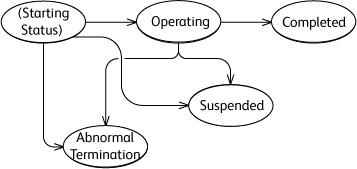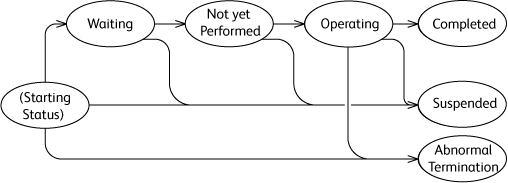
This is also called "Workflow Instance" in the general workflow systems.
The workprocess manages each activity status based on the Workflow definition. For example, [Reimbursement of Traveling Expenses to Sendai on February 10th] is the workprocess to [Workflow Definition for Reimbursement of Traveling Expenses].
The status transition of a workprocess is as shown below.

Fig.: Status Transition of Workprocess
A work consists of activities,
and each activity consists of performers and the works by the performers. The status transition of an activity is as shown below.

Fig.: Status Transition of Activity
| Item | Description |
|---|---|
| User Activity | An activity that is performed interactively by activity performers via a form. The activity is performed by completing a form which is forwarded to the performer. |
| Collaboration Activity | An activity that uses the collaboration function. |
| Block | A block is an abstract expression of multiple activities integrated in one. A block allows you to put a Workflow definition into a hierarchical view. |
| Auto Activity | Auto activities are automatic operations performed by Workflow Management Services. Auto activities includes application tasks (e.g. registering documents, creating tasks, etc.) and execution control tasks. There are the following three types of auto activities:
|
| Routing Activity | An activity for routing control. There are the following three types of routing activities.
|